by Mark Hudson | Nov 29, 2018 | Firewood
At this time of year, it may be difficult to find firewood when you need it. Why? Because many suppliers have been selling out their supply for months and any wood you cut now will not be good for burning. In order for your fireplace, stove, or insert to work properly, you must burn only properly seasoned firewood. This means your wood should be cut many months before burning, and stored until winter.
Can You Burn Fresh Wood? 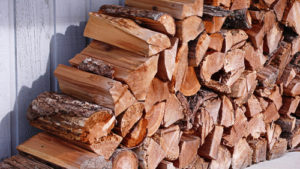
Yes. You CAN burn freshly cut wood. If your family is freezing, and the only wood you have to burn is freshly cut, it will burn. It will be difficult to light, will not reach a high temperature, will burn incompletely, produce more smoke than heat, and will put more creosote in your chimney than necessary. To reach the desired temperature, a homeowner may use three times more wood than you would with properly seasoned firewood. This wastes fuel and damages your system.
Properly Seasoned Wood
Your firewood was once a live tree which stored and used water in order to live. When it’s cut, it likely has a water content higher than 75 percent. When you burn this “green” or “wet” wood, it has to first evaporate the water before burning the fuel (wood). Think about it like this: you’re camping in the rain and attempting to light a fire. Would you use wood that has been soaked with rainwater, or would you dig through brush and grasses to find dryer pieces? Firewood is the same. The best-burning wood is cut and allowed to dry for 3-6 months before being burned. This ensures a water content of less than 35 percent.
DIY Seasoned Firewood.
First, find a good supply of the type of tree you’d like to harvest. Harder species of wood burn differently than softer ones, but all will burn well when properly-seasoned.
Next, cut the tree down, and cut it to the desired length. Letting the wood sit like this will allow water to drain and evaporate from the ends faster than letting a felled tree dry. Letting the whole tree sit will likely result in a rotted tree, not seasoned firewood.
Finally, store the firewood until you need it. If you wait to split your firewood until it’s dry, it will be easier to split and lighter to carry.
Buying Firewood
It may be that you do not have a good source for firewood on your land. You can still have a wood fire by purchasing seasoned firewood from a local supplier. When searching for a supplier, look for wood that is cut and stacked in piles that look seasoned. It is seasoned firewood if it is gray in color, light in weight, has cracks along edges, and the bark pulls away from the flesh. Don’t pay too much for a cord or rank of wood. Make sure you understand what these terms mean, and how much you should be paying.
How to Store Your Supply
Whether you’re storing bought or self-cut wood, use an open pile, a tarp, or a shed. The only mistake you can make storing firewood is enclosing it tightly to prevent airflow. Air and light are necessary to season the firewood properly.
Hudson Chimney can help you determine if your fireplace problems are from improper wood. We may even be able to help you find a supplier. Contact Hudson Chimney today for help at 904-282-4159.
by Mark Hudson | Dec 31, 2015 | Firewood
The most important factor for the best firewood is for it to be seasoned, or dried, sufficiently. You can find firewood dealers who only sell seasoned wood, but you must store it properly to keep the wood dry. At Hudson Chimney, we are often asked by our customers for the best ways to store firewood, so we thought we would share some firewood storing tips with you to help you protect your wood fuel from the elements.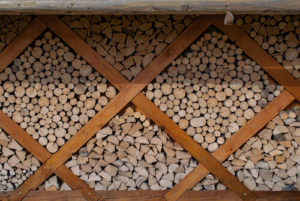
Always store your firewood off the ground.
When you stack your firewood directly on the ground, you are allowing it to absorb moisture from the ground. Even if your wood was seasoned, it will be too wet to burn if it is stored on the ground. If you do not have a storage shed, you can place your stacks of firewood on top of pallets, drain-able gravel, or a tarp.
Cover the top of your stacks of firewood.
To protect your firewood from getting wet from rain, you should place a tarp on top of the wood. Leave the sides of the stacks uncovered so that moisture will not get trapped inside and absorbed into the wood. With the sides open, air will be able to circulate and further the drying process.
Stack your wood properly.
Never stack firewood higher than four feet high. You do not want your stacks to be wobbly, unsteady, and in danger of falling over. Give each stack a few inches of breathing room to allow air to circulate, but you do want to place the stacks close enough together to discourage children and animals from climbing around them.
Build a storage shed.
According to Inman, creating a firewood storage shed is not that difficult. All you need is a raised floor, a sloped roof, and open sides so that the air can circulate and that you can easily get the wood when needed. You will want to build a big enough shed to store a year’s supply of firewood.
Create a smaller storage area inside your home.
If you have a garage or basement, you can store up to a week’s worth of firewood inside your home. This can be very convenient because you will only need to go outside to gather firewood once a week. If you do not have a garage or basement, you can get creative by using a decorative metal tub in your home to store a small supply of firewood.
If you would like more firewood tips, contact us at Hudson Chimney. We are happy to help you enjoy warm and cozy wood fires this winter.
by Mark Hudson | Dec 15, 2014 | Firewood
If you have a wood burning fireplace or stove, you may wonder if there is anything of significance that you can do to maintain the efficiency, safety, and health of your appliance. The answer is yes! By choosing the best firewood to burn in your appliance, you can protect your chimney or stovepipe from rapid creosote build-up and your home from dangerous chimney fires. Not only this, but the right firewood will help you to create fires that are warmer and more enjoyable.
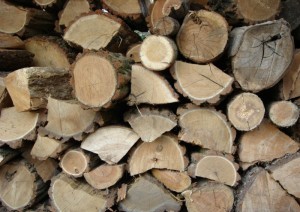
Regardless of the type of woodburning appliance you own, you should only burn seasoned firewood. According to the Chimney Safety Institute of America, the distinction between seasoned and unseasoned firewood is its moisture content. Seasoned firewood has a low moisture content, usually between 20 and 25 %. Unseasoned firewood, on the other hand, can have a moisture content as high as 45 %. Burning firewood with a higher moisture content can cause you and your chimney a number of problems, from the unpleasant to the dangerous. You will have trouble enjoying your chimney if you burn unseasoned firewood because of the unpleasant smell and smoke it produces. However, your biggest concern is that the water in unseasoned firewood will allow for creosote to rapidly build up in your chimney. Creosote is highly flammable, creating a hazard for chimney fires, and can build up into glazed creosote, which can only be removed from your chimney by a professional with chemicals.
If you chop your own firewood, it is easy to know if it is seasoned or unseasoned. Simply be sure to cut your firewood to length six months before you plan to use it in order to give water in the wood time to environment. Cutting your wood to length opens up the microscopic tubes in the wood that hold water, which allows the water to escape.
If you buy your firewood, it is a little more difficult to tell if your firewood has been properly seasoned. The best way to be sure your firewood has been properly seasoned is to buy it six months before you intend to use it and store it properly. However, seasoned and unseasoned firewood have characteristics that differentiate them from each other that you can utilize to see if the firewood you are buying has been seasoned. Seasoned firewood has darker ends and more cracks than unseasoned firewood and also tends to be lighter. Seasoned firewood also makes a clunking rather than a thudding noise when it is hit.
Whether or not you buy or chop your firewood, you must be sure that it is properly stored. A wood shed is the best place to store firewood. However, you can also store wood in a sunny location as long as you remember to cover the wood when it rains or snows. No matter where you store it, make sure that air is allowed to circulate to promote evaporation and try to store the wood off of the ground.
Give Hudson Chimney a call if you are unsure if you are burning the correct kind of firewood or if you have concerns regarding creosote build-up. The professionals at Hudson Chimney know how to keep you and your home warm and safe!
by Mark Hudson | Nov 15, 2014 | Firewood
If you have a wood burning appliance, then you have more control than you probably think over the way your appliance runs. The type of wood you burn influences how efficiently your chimney runs in addition to the overall health of your chimney. It is important, then, that you choose to burn seasoned firewood. According to the National Chimney Safety Institute of America, burning seasoned firewood will allow your appliance to burn cleaner and more efficiently than burning unseasoned firewood. In fact, whether or not your firewood is seasoned is far more important than the species of wood you burn.
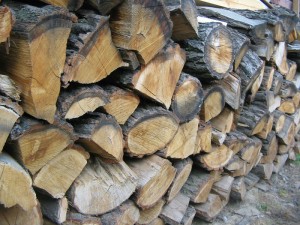
You may be wondering what the difference is between seasoned and unseasoned firewood as well as why this difference is important. All wood has a certain amount of water in it. Seasoned firewood has moisture content of 20 to 25 percent while unseasoned wood can have a moisture content of up to 45 percent. Burning unseasoned wood is inefficient because energy is lost to drying the wood before burning it, leading to a lower heat output. Not only this, but burning unseasoned wood also leads to more creosote build up in your chimney or stovepipe.
In order to make sure that your firewood is seasoned if you chop it yourself, cut it to length at least six months before using it. Splitting and cutting the firewood to its proper length gives the wood more exposure to the sun and wind, allowing evaporation to occur. If you buy your firewood, it is good to buy it the spring before you use it to ensure that it is well seasoned. However, if you buy your firewood close to the time you burn it there are several ways to tell if the firewood you are buying is seasoned. Check to make sure that the ends of the firewood are cracked and darkened and that the wood is light and makes a “clunking” noise when two pieces are hit together. Unseasoned firewood will be heavier.
The way you store your wood is also important to the way it will burn. If your firewood is exposed to snow and rain, it will absorb too much water to burn properly and possibly rot. Store your wood off of the ground and cover it in the case of bad weather. Leave it uncovered on sunny days to allow evaporation to occur.
When burning wood, make sure that you do not burn wood that has been painted or treated, which can cause toxic fumes to be released into your home. Also, if you end up burning unseasoned wood, it is important that you have your chimney or stovepipe frequently cleaned and inspected to avoid hazardous creosote build up.
If you are unsure about the type of wood you should be burning in your fireplace, ask an expert at Hudson Chimney during your annual chimney cleaning and inspection. The professionals at Hudson Chimney have the knowledge and training to help you determine the best choices for your chimney in order that it run efficiently and safely.
by Mark Hudson | Sep 13, 2013 | fireplaces
Wood vs. Gas Fireplace
There is something comforting about gathering around a fireplace when the weather is cold. Those who already have them in their homes can count themselves lucky. But what if you are looking to add one to your home? Should you choose wood-burning or gas? This is a debate that has been going on for years, but the reality is that there are advantages and disadvantages to both.
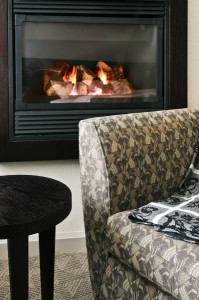
There are advantages and disadvantages for both wood and gas fireplaces. A certified sweep can help you make the best decision for your lifestyle.
Most real estate agents agree that adding a fireplace of any kind will add value to a home but a wood burning fireplace will most likely add a little more than a gas fireplace. Most people enjoy the authentic nature of a wood burning fireplace and having heating and cooking independence from utility companies is a big plus. When the power goes out those with wood-burning fireplaces will have heat and cooked food. They also provide a convenient way to dispose of fallen branches or other wood debris that may have collected around a property. There is also something to be said about the atmosphere a wood-burning fireplace creates that is unmatched by any of its contemporaries. There are however some disadvantages. Wood-burning fireplaces can be messy and expensive to maintain. The burning of wood produces gases that will cool as they go up the chimney and turn into creosote which will stick to the sides of the chimney and can create a fire-hazard. This requires that the chimney be regularly cleaned. The cost of owning and operating a wood-burning fireplace is also higher than it is to operate a gas fireplace. Gas is cheap and burns cleaner than wood and takes a lot less time and maintenance to operate.
To those who may not want to deal with the mess and maintenance or a wood-burning fireplace gas logs may be the answer. Gas logs are dependent on the gas supply but they are cleaner burning options and offer a measure of safety. You don’t have to worry about a stray spark igniting your home and there is no need to stock up on firewood. The cleaning and maintenance of a chimney with gas logs is much less than that of a wood-burning fireplace but it still requires some attention especially if it was originally a wood-burning system. Water can do more damage to a chimney than fire and if unchecked can cause extensive damage.
Whether you choose wood-burning or gas logs a fireplace is a great addition to any home with the proper respect. They both produce fire and both must be protected from children and pets and require proper maintenance to maintain a safe functionality. If you do that you will be happy with whatever decision you make.





